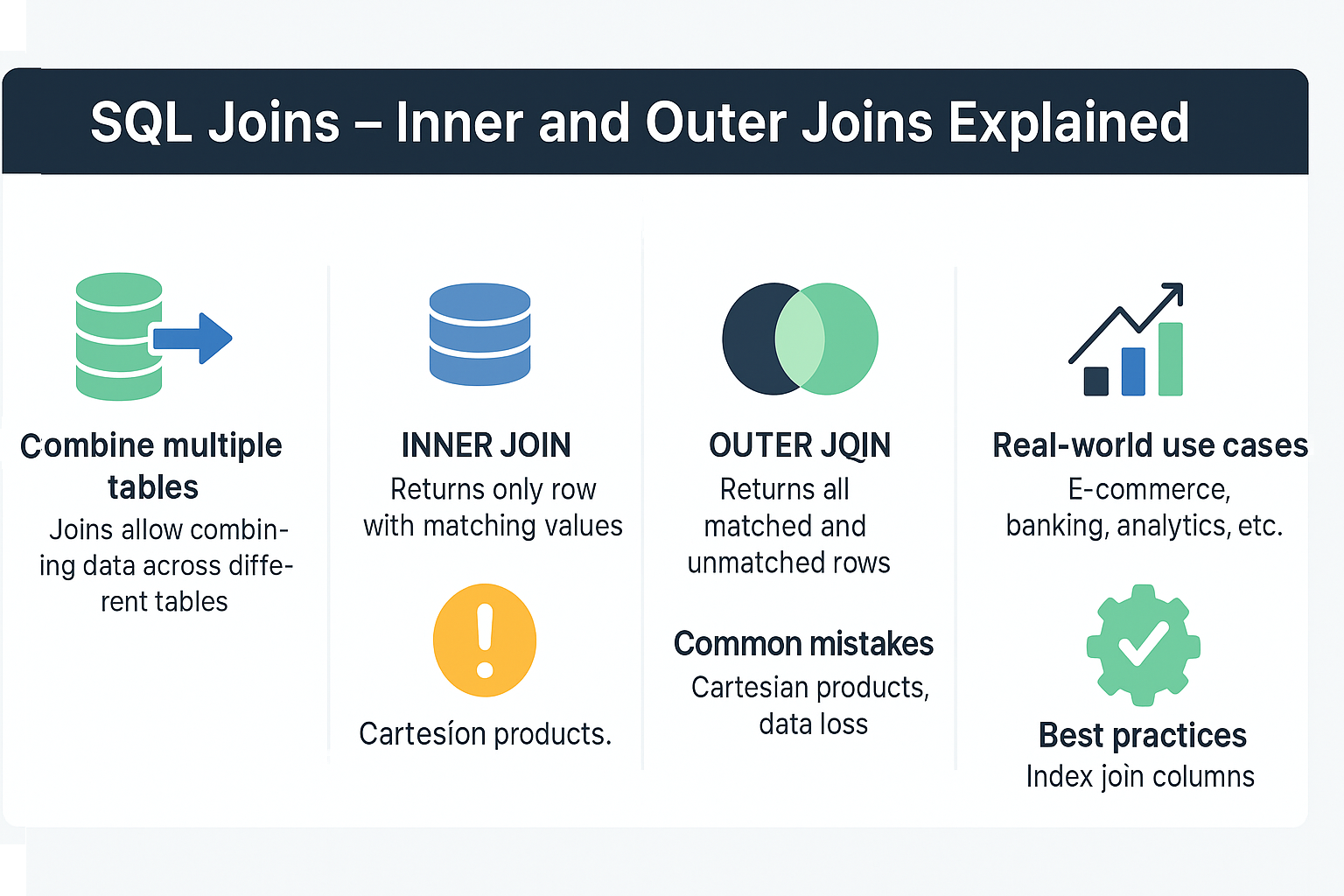Introduction
SQL Joins are used to combine data from multiple tables based on related columns. They are critical for relational database queries and enable you to build complex reports and analytics.
Why Joins Matter
- Allow combining data from different tables.
- Support normalized database structures.
- Enable complex querying and relationships.
Real-world analogy:
Imagine two lists: one with customer names and another with their orders. A join is like matching customers to their orders to get a complete picture.
Core Concepts
INNER JOIN
Returns rows where there is a match in both tables.
OUTER JOIN
Returns rows even when there is no match, filling missing values with NULL.
- LEFT OUTER JOIN: All rows from the left table and matching rows from the right.
- RIGHT OUTER JOIN: All rows from the right table and matching rows from the left.
- FULL OUTER JOIN: All rows from both tables, matched where possible.
SQL Examples
Sample Tables
Customers:
| customer_id | name |
|---|---|
| 1 | John Smith |
| 2 | Jane Doe |
| 3 | Mike Ross |
Orders:
| order_id | customer_id | product |
|---|---|---|
| 101 | 1 | Laptop |
| 102 | 2 | Keyboard |
| 103 | 4 | Mouse |
INNER JOIN Example
SELECT c.name, o.product
FROM customers c
INNER JOIN orders o ON c.customer_id = o.customer_id;
Result:
| name | product |
|---|---|
| John Smith | Laptop |
| Jane Doe | Keyboard |
LEFT JOIN Example
SELECT c.name, o.product
FROM customers c
LEFT JOIN orders o ON c.customer_id = o.customer_id;
Result:
| name | product |
|---|---|
| John Smith | Laptop |
| Jane Doe | Keyboard |
| Mike Ross | NULL |
RIGHT JOIN Example
SELECT c.name, o.product
FROM customers c
RIGHT JOIN orders o ON c.customer_id = o.customer_id;
Result:
| name | product |
|---|---|
| John Smith | Laptop |
| Jane Doe | Keyboard |
| NULL | Mouse |
FULL OUTER JOIN Example (PostgreSQL/Oracle)
SELECT c.name, o.product
FROM customers c
FULL OUTER JOIN orders o ON c.customer_id = o.customer_id;
Result:
| name | product |
|---|---|
| John Smith | Laptop |
| Jane Doe | Keyboard |
| Mike Ross | NULL |
| NULL | Mouse |
Real-World Use Cases
- E-commerce: Combine customers and orders for reports.
- Banking: Join accounts and transactions.
- Analytics: Merge user activity with demographics.
Common Mistakes and Anti-Patterns
- Forgetting join condition: Creates Cartesian products.
- Using INNER JOIN when you need all records: Data loss risk.
- Not indexing join columns: Causes slow queries.
Performance and Scalability Implications
- Joins on large tables can be expensive; proper indexing is critical.
- Avoid joining too many tables in one query for OLTP systems.
- Use EXPLAIN to analyze join performance.
RDBMS Comparison
| Join Type | PostgreSQL | MySQL | Oracle |
|---|---|---|---|
| INNER JOIN | Supported | Supported | Supported |
| LEFT/RIGHT JOIN | Supported | Supported | Supported |
| FULL OUTER JOIN | Supported | Emulated with UNION | Supported |
Best Practices & Optimization Tips
- Index foreign key and join columns.
- Use explicit JOIN syntax instead of implicit joins.
- Limit selected columns to reduce I/O.
- Avoid unnecessary joins; denormalize if needed for performance.
When to Use vs When to Avoid
Use Joins When:
- Combining related data from multiple tables.
- Querying normalized database structures.
Avoid Excessive Joins When:
- Performance is critical and denormalization is acceptable.
Conclusion & Key Takeaways
Joins are the backbone of relational database queries. Mastering INNER and OUTER joins enables building complex, efficient, and meaningful SQL queries.
Key Points:
- INNER JOIN returns matching rows.
- OUTER JOIN includes unmatched rows with NULLs.
- Proper indexing and query design are crucial for performance.
FAQ
1. What is the difference between INNER and OUTER JOIN?
INNER returns only matching rows; OUTER includes unmatched rows with NULLs.
2. What is a LEFT JOIN?
Returns all rows from the left table and matching rows from the right.
3. Can I join more than two tables?
Yes, multiple joins are supported.
4. Is FULL OUTER JOIN available in MySQL?
Not directly; emulate using UNION of LEFT and RIGHT joins.
5. Are joins expensive in SQL?
They can be if not indexed properly or on huge tables.
6. What is a Cartesian product?
Result of joining without a condition; returns all combinations of rows.
7. Can I use WHERE with JOINs?
Yes, to filter joined results.
8. Are NATURAL JOINs recommended?
No, explicit join conditions are preferred for clarity.
9. Can joins be used across databases?
Some RDBMS support cross-database joins if on the same server.
10. What’s better for performance: JOIN or subquery?
Depends on use case; joins are generally more optimized by the query planner.
